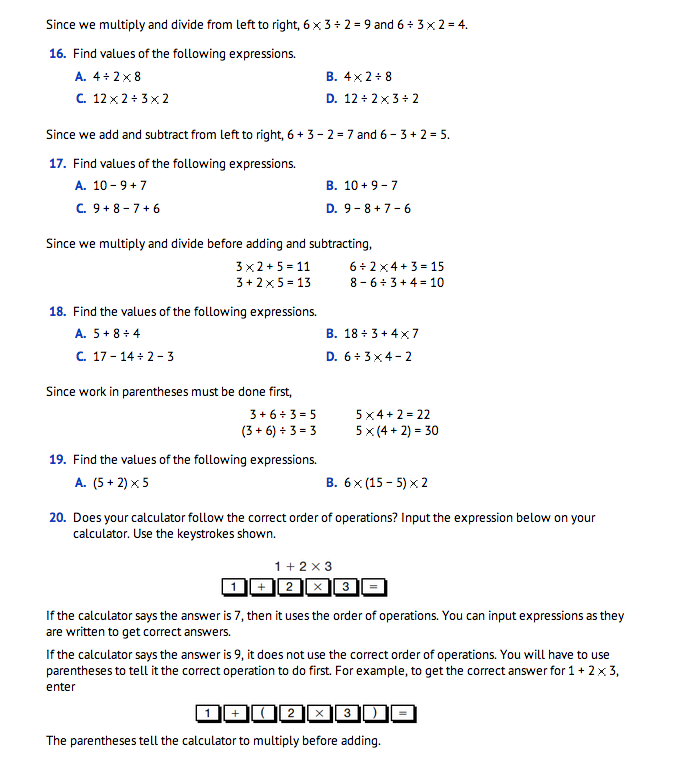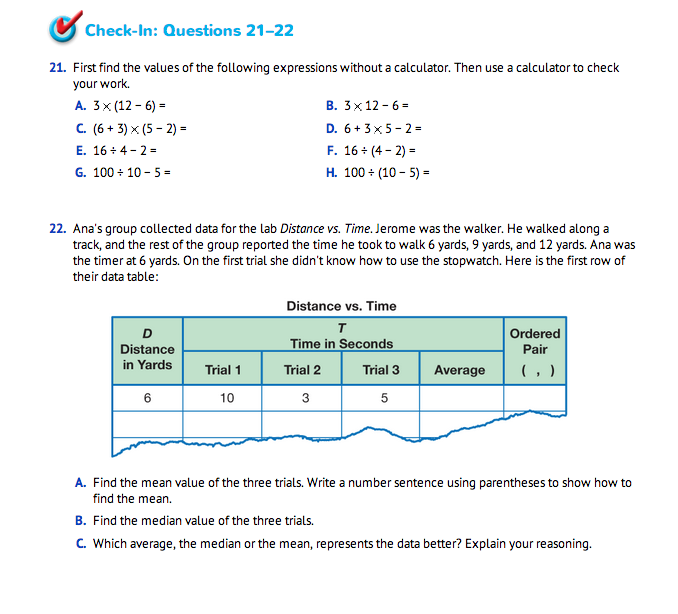Use the Student Guide to review order of operations and to introduce the use of parentheses in the context of calculating averages on a calculator. Explain to students that parentheses are often used in numerical expressions, and many people use them to do calculations on calculators. A numerical expression is a combination of numbers and number operations. In any expression, the calculations inside the parentheses must be done first.
In Question 14, students compute 3 + 7 × 2 in two different ways. When they add first and then multiply, they will get 20. When they multiply first and then add, they will get 17. This brings out the need to clarify the order in which the operations should be done.
Parentheses are introduced as a way to do this. For example, in the expression (4 + 6) ÷ 5, we first compute 4 + 6 = 10. Then the problem becomes 10 ÷ 5 = 2. In Question 15, students evaluate expressions using parentheses. Questions 16–19 first review the correct order of operations in expressions without parentheses: multiplication and division are done before addition and subtraction. Remind students to multiply and divide from left to right and then add and subtract from left to right when evaluating expressions. See the examples in Figure 2.

Calculators and the Order of Operations. Scientific calculators and some other calculators calculate expressions using the correct order of operations. Thus, entering  on a scientific calculator will give the correct answer of zero. Many simple four-function calculators carry out all operations in the order they are entered rather than follow the correct order of operations. Such a calculator will give the incorrect answer of six. In order to check whether a calculator has the order of operations built in, experiment with an expression such as the one above. If students do not have calculators that use the correct order of operations, they will have to enter the operations in the correct order themselves.
on a scientific calculator will give the correct answer of zero. Many simple four-function calculators carry out all operations in the order they are entered rather than follow the correct order of operations. Such a calculator will give the incorrect answer of six. In order to check whether a calculator has the order of operations built in, experiment with an expression such as the one above. If students do not have calculators that use the correct order of operations, they will have to enter the operations in the correct order themselves.

Avoiding Misconceptions. Various mnemonic devices are sometimes offered to help students remember the order of operations. While these kinds of memory devices are helpful in remembering some things, we strongly advise against their use in teaching this topic.
The mnemonics that are commonly used to remember order of operations often lead to incorrect computations. These include the phrase Please Excuse My Dear Aunt Sally, or simply the acronym PEMDAS. They remind students to do the operations in this order: parentheses, exponents, multiplication, division, addition, subtraction. This is an incorrect order—it suggests that multiplication is done before division and addition is done before subtraction. This suggestion could cause a student to evaluate the expression 8 − 4 + 1 as 3. The correct answer, gotten by evaluating left to right (because addition and subtraction have the same priority) is 8 − 4 + 1 = 5. Similarly, since multiplication and division have the same priority, 8 ÷ 4 × 2 = 4. A student who follows the rule given by PEMDAS and does the multiplication first would incorrectly calculate 1 to be the answer.
To state the rule correctly, proponents often present the acronym with the additional condition that M and D are at the same level, and A and S are at the same level. But our experience shows that as memory fades, many students and adults remember only the acronym PEMDAS, but not the extra condition.
We recommend simply stating the priority levels as given in the Student Guide (stated without exponents at this time):
- Parentheses first.
- Multiplication and division from left to right.
- Addition and subtraction from left to right.
Instead of offering a mnemonic, encourage students to think why this order makes sense: multiplication and division are at the same priority level because they “go together”—one is the inverse of the other—so neither is higher than the other. They are more complicated so we do them first to get them out of the way. Addition and subtraction “go together” too, so they have the same level of priority. They are the final step—they put all the pieces together.
Question 20 provides a test for students to check if the calculators they are using follow the order of operations. A similar test is shown in the Content Note.
Assign Check-In: Questions 21–22 for students to complete independently. Students evaluate expressions following the order of operations using parentheses with and without a calculator, find the mean and the median, and compare the use of the mean and median to represent the data set.
Use students' responses to Check-In: Questions 21–22 in the Student Guide and the corresponding Feedback Box in the Teacher Guide to assess students' abilities to follow the order of operations [E4]; find the mean and median of a data set [E13]; and show their work so someone else can understand their thinking [MPE5].
Homework Questions 7–22 on the Mean or Median pages in the Student Guide can be assigned at this time.













 on a scientific calculator will give the correct answer of zero. Many simple four-function calculators carry out all operations in the order they are entered rather than follow the correct order of operations. Such a calculator will give the incorrect answer of six. In order to check whether a calculator has the order of operations built in, experiment with an expression such as the one above. If students do not have calculators that use the correct order of operations, they will have to enter the operations in the correct order themselves.
on a scientific calculator will give the correct answer of zero. Many simple four-function calculators carry out all operations in the order they are entered rather than follow the correct order of operations. Such a calculator will give the incorrect answer of six. In order to check whether a calculator has the order of operations built in, experiment with an expression such as the one above. If students do not have calculators that use the correct order of operations, they will have to enter the operations in the correct order themselves.



